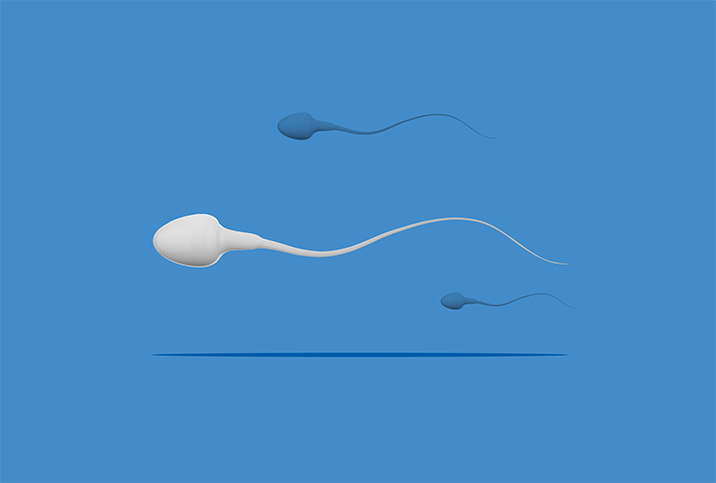We Have Questions: Male Subfertility

Key Points
- Subfertility is different from infertility, or when a couple is unable to become pregnant in a year of trying.
- Both male subfertility and infertility are more common than most people assume.
- About half of all couples with fertility complications experience them as a result of issues with the male partner.
Infertility is often regarded as a women's issue, but research shows that half of couples who can't have babies owe their issues to male fertility problems.
Infertility falls on a wide spectrum, however, said Justin Dubin, M.D., a urologist and men's health specialist with Memorial Healthcare System in Miami. In some cases, men may be infertile—meaning the likelihood of conceiving without assisted reproductive technology (ART) is unlikely.
A couple is typically diagnosed as "infertile" when they are unable to achieve a pregnancy after one year of unprotected sex, Dubin said. Infertility affects an estimated 1 in 6 couples, according to the World Health Organization (WHO).
In other instances, men may be considered subfertile. "Subfertile" is a term used when the potential for a couple to conceive exists but that conception is delayed. In both situations, low sperm count may be a culprit—but not always, Dubin said.
"Many men with less-than-normal semen parameters never have an issue achieving a pregnancy," Dubin said. "Then, there are men out there who have completely normal semen parameters who struggle with fertility. The fertility picture can be very complicated."
To help dispel confusion and stigma, Dubin addressed questions about male subfertility causes, treatments and lifestyle factors.
Editor's note: This interview has been edited for length and clarity.
What are some of the common causes of male subfertility?
Dubin: There are many possibilities. There are genetic causes, such as cystic fibrosis, a condition in which you are born without a vas deferens, the highway that carries the sperm from the testicle to the outside world. With cystic fibrosis, you have sperm—it's just not able to get out.
Then, there are anatomy problems. About 15 percent of men have varicoceles, or dilated veins around the testicle. About 40 percent of men with fertility issues have varicoceles—though they don't necessarily cause infertility in everyone.
Another important cause of infertility is testosterone usage. Many men are not aware that using testosterone can and often will kill your sperm and cause you to become sterile. Roughly 65 percent of men with normal sperm parameters become sterile within just four months of starting testosterone, suggested a 2019 study.
Testosterone is important for the testicles to create sperm, and having low testosterone can also cause fertility problems. Medical problems such as obesity, diabetes and cancer can compromise your testosterone levels and fertility, either temporarily or permanently.
There are medicines that can improve your testosterone that don't cause infertility like testosterone supplements do.
Another common cause of fertility problems in men is wet heat exposure. Your testicles are outside of your body for a reason: For sperm to develop, they have to be a couple of degrees cooler. So when you're going in a hot tub, sauna or steam room, you could potentially compromise your parameters for up to three months, the average length of a sperm cycle.
Finally, there are causes that we don't always think about, such as infrequent ejaculation, which can lead to poor-quality sperm. Lubricants are another little-known factor that can compromise male fertility. Most lubricants can kill your sperm.
Other risk factors for fertility problems in men include smoking and vaping. Marijuana usage can also contribute to problems.
When should someone seek treatment for subfertility, and from whom?
It depends a lot on your female partner's age.
If your partner is under 35, the recommendation is you can wait up to a year. If you've been struggling for a year and your partner is under 35, you should see a physician.
Guidelines recommend seeing someone at six months if your female partner is between 36 and 40.
If your partner is over 40 and you're interested in having a child, we often recommend going as soon as you decide. We don't want to delay care and take any additional time away from that process.
All that said, if you are interested in learning about your fertility, you don't have to wait. Go talk to your urologist and have your partner talk to a reproductive endocrinologist.
Recommended
- Coping With Men's Infertility: Male infertility is a more common problem than you might think, but you have many paths forward.
- Managing the Emotional Impact of Infertility: Take time to process your feelings and seek support when dealing with infertility.
- Examining the Primary Causes of Male Infertility: Most infertility issues can be assessed and treated, but some cases are 'unexplained.'
How are male subfertility and infertility diagnosed?
If you come into my office for fertility testing as a man, we do four things.
One, I get a medical history. I assess medical and lifestyle problems that might put you at risk. This includes getting a medical history of your partner.
Next, I do a physical exam. I make sure your anatomy is all normal. I assess your testicle size. I check the vas deferens to see if there are sperm present.
Then, I get blood work to measure the level of testosterone and other hormones.
The final step is the most important: semen analysis. In a semen analysis, I assess whether you're making sperm and what it looks like. I check sperm volume, or the amount of sperm in your ejaculate.
I assess the motility of your sperm, or whether they can swim. You could have a billion sperm, and if they can't swim, they're not going to get anywhere. Then, I check the morphology, which is the shape of the sperm.
What treatment options are available for subfertility in men?
There are a lot of factors involved with fertility. The most important factor comes down to whether there is sperm or not. If there is sperm, we can look at other factors, including your medical history and lifestyle, to see if we can modify them to optimize your fertility.
For example, if you have low testosterone, you can make adjustments in your lifestyle. You can stop smoking cigarettes or going in the hot tub every day. If you're overweight, we can talk about eating and weight loss.
If there's zero sperm in your ejaculate, a condition known as azoospermia, we have to figure out if it's a blockage issue—meaning the sperm is being made but it can't make it out of the testicle or the penis or the urethra—or if it's a production issue in which the testicle isn't functioning.
In both instances, there may be an option to retrieve sperm. We could do a surgery in which we open the testicle and take out the tissue to see if we can find sperm.
Can lifestyle improvements help with male subfertility?
It's pretty amazing how your lifestyle impacts your overall health, sexual health and fertility.
If you have diabetes or you're overweight, that could cause low testosterone, which can compromise your fertility. If you are losing weight and improving your health, if you're not smoking and you're exercising regularly, these things can improve overall health and potentially improve your fertility.
Any parting advice for men concerned about subfertility?
It's important for men to understand that there's this unfair stigma and pressure on women when it comes to fertility. We, as men, contribute just as much to couple fertility problems. If you really want to be the best partner, talk about this stuff with your doctor.
You're taking pressure away from your partner, and you're helping move things forward toward achieving your goal of having a family.


















